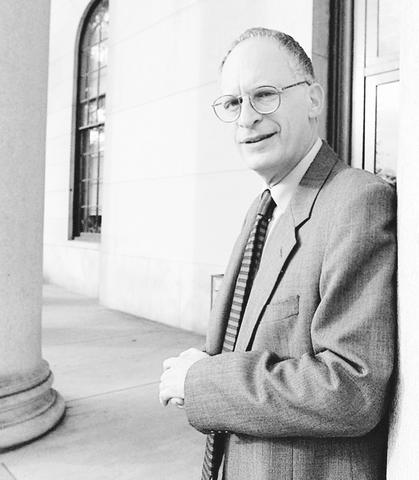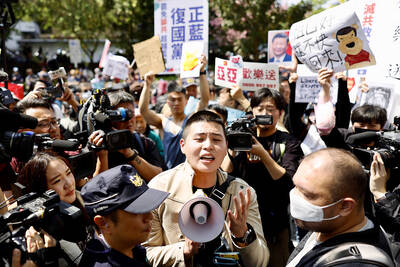Last March, when former Treasury Secretary Lawrence H. Summers was named the 27th president of Harvard University, nowhere was the popular choice greeted with more enthusiasm than on the second floor of Littauer Center, home to the economics department.
"People were delighted," said Oliver Hart, the department's chairman. "Larry has a lot of friends here."

PHOTO: NY TIMES
Favorite son
It's no wonder. Summers, 47, is almost a pure product of Harvard's economics department: While he attended the Massachusetts Institute of Technology (MIT) as an undergraduate, he received a Harvard doctorate in 1982, became the youngest tenured member ever of its faculty at age 28, and taught there for eight years before leaving for Washington in 1991.
More importantly, Summers -- whose sharp rise has given him enormous influence in policy and scholarly circles -- epitomizes the increasingly important position that Harvard now holds in the world of academic economics.
Harvard's economics department is on a roll these days, attracting a disproportionate number of the most coveted graduate students and turning out an equally hefty share of the most promising young economists. And making it all the sweeter is that Harvard's rise is helping it eclipse the profession's traditional lodestar, the economics department at cross-town rival MIT.
"We feel we are currently winning the competition," Hart said. "Over the past five to eight years, things have moved in our direction."
Ben Bernanke, who now chairs Princeton's economics department, recalls that MIT was long the premier incubator of economists and an intellectual hothouse that thoroughly overshadowed Harvard.
Indeed, when he was an undergraduate at Harvard in the 1970s, even Bernanke's own Harvard academic adviser recommended that he apply at MIT.
"He told me that's where all the best students went, and he was right," Bernanke said.
That's no longer true. "Now, things aren't so clear-cut," he said.
One reason the balance of power in Cambridge has shifted is because Harvard has made itself a much better teaching institution.
At the same time, MIT has become, relative to Harvard at least, a less attractive place to study economics, in large part because it has suffered a number of prominent defections from its faculty over the past decade.
The altered competitive landscape between the two schools represents another twist in a long, storied rivalry, but it also reflects the changes that have swept the field of economics generally.
In a sense, MIT's department is being victimized by its own success. It has remained a small shop as the profession it led to prominence has become a sprawling subject.
Moreover, the discipline's biggest names are now virtually celebrities, with opportunities extending beyond the lecture hall. Yet MIT clings to the egalitarianism that has always been its trademark; one former faculty member jokingly calls it "the last kibbutz in economics."
Whatever their comparative strengths and weaknesses, which each admit around 25 doctoral candidates annually, still boast what are widely acknowledged to be the two finest graduate programs in economics.
Storied rivalry
The rivalry between Harvard and MIT is fueled nowadays primarily by proximity and ego. "It's the narcissism of small differences," says Michael Kremer, a specialist in issues of growth and development who jumped from MIT to Harvard two years ago. And while Harvard is a more politically active department, there is no real ideological divide.
Both departments lean to the left politically, though Harvard is more catholic in its composition: its faculty includes two leading conservative economists, Robert Barro and Martin Feldstein.
Each school practices what is known as Cambridge-style economics:
While heavily mathematical, it is less formalistic and theoretical than the economics done, for example at the University of Chicago -- another storied institution that has a weaned dozens of well-known economists.
Many of the professors and students have taught or studied on both campuses, and there is frequent collaboration among faculty members. Except during recruiting season. "Recruiting is a good old-fashioned fight," said Olivier Blanchard, MIT's chairman.
"It usually takes a few weeks for friendships to be restored. Apart from that, it's a state of generalized incest."
It's a rivalry, however, that was conceived in bad blood. In October 1940, a remarkably gifted 25-year-old economist named Paul Samuelson, then an instructor at Harvard, was offered a professorship by MIT, which at the time had a threadbare economics department.
Harvard was expected to eagerly match the offer, but it didn't.
It was widely understood that Samuelson was snubbed because he was Jewish.
Even those who saw it differently acknowledged that anti-Semitism was a factor: the renowned Austrian economist Joseph Schumpeter, who was then teaching at Harvard, remarked: "I could understand if they didn't want to hire him because he is a Jew. But that wasn't it: he was just too brilliant for them!"
From his perch at MIT, Samuelson revolutionized economics. Although firmly in the Keynesian camp, his foremost achievement was to unite a century's worth of economic insights, many of them seemingly at odds, into a single, coherent theory -- the neo-classical synthesis, as it was called -- that would dominate economic discourse for some three decades.
He also wrote a primer on economics that, 50 years later, remains a popular introductory textbook around the world.
In the early '50s, he was joined at MIT by another talented young refugee from Harvard, Robert Solow. Together, Samuelson and Solow turned MIT into the institution that best embodied mainstream economic thought.
They were distinguished not just for their pathbreaking work, but for their dedication to nurturing students as well.
From the 1950s through the 1980s, Harvard's economics department was no match for MIT's. While it had a fine faculty, professors were not particularly interested in teaching either undergraduate or graduate students, who were often left to sink or swim on their own.
Not a first choice
"One was hesitant to send students to Harvard," said David Colander, an economic historian at Middlebury College. "You knew they would receive a good education at MIT; at Harvard, they would have to educate themselves."
Consequently, MIT almost always beat out Harvard for the most prized doctoral candidates.
In the early 1990s, however, the first signs of shifting fortunes emerged. Samuelson and Solow, along with other members of the Old Guard, began to retire even as MIT lost some younger stars as well.
In 1993, both Hart and Drew Fudenberg, two leading microeconomist theorists, bolted for Harvard. Shortly thereafter, Jean Tirole, another microeconomic theorist, returned to his native France.
Meanwhile, Harvard was becoming a more user-friendly place, thanks mainly to an influx of MIT economists who had been reared on the Samuelson-Solow ethos and tradition.
"In the past, if you were a graduate student, you really took your chances coming here," Hart, the department's chairman, said. "But the culture has changed.
"We're able to compete with MIT now because we have people who were taught in the MIT tradition and believe in treating graduate students well," Hart said.
In the meantime, MIT's faculty exodus has continued unabated. Besides losing Kremer, the department could not prevent Susan Athey, a highly respected and much-sought-after microeconomist, from going to Stanford.
It also suffered an even bigger defection: Paul Krugman, arguably the world's most influential trade theorist and also a columnist for The New York Times, was lured away by Princeton University in New Jersey.
MIT now finds itself at a disadvantage on several fronts. Over the past few decades, economics has flowered into a broad, highly specialized field. With some 60 full-time faculty, Harvard can blanket the subject. MIT's economics department is half that size.
"It seemed to me that Harvard is a better place if you don't know exactly what you want to study," said one student there, who graduated from Princeton last May and chose Harvard's economics program over MIT's.
"It's got almost every area covered, and in almost every area it has people who are at the top of the field," the student said.

ENDEAVOR MANTA: The ship is programmed to automatically return to its designated home port and would self-destruct if seized by another party The Endeavor Manta, Taiwan’s first military-specification uncrewed surface vehicle (USV) tailor-made to operate in the Taiwan Strait in a bid to bolster the nation’s asymmetric combat capabilities made its first appearance at Kaohsiung’s Singda Harbor yesterday. Taking inspiration from Ukraine’s navy, which is using USVs to force Russia’s Black Sea fleet to take shelter within its own ports, CSBC Taiwan (台灣國際造船) established a research and development unit on USVs last year, CSBC chairman Huang Cheng-hung (黃正弘) said. With the exception of the satellite guidance system and the outboard motors — which were purchased from foreign companies that were not affiliated with Chinese-funded

PERMIT REVOKED: The influencer at a news conference said the National Immigration Agency was infringing on human rights and persecuting Chinese spouses Chinese influencer “Yaya in Taiwan” (亞亞在台灣) yesterday evening voluntarily left Taiwan, despite saying yesterday morning that she had “no intention” of leaving after her residence permit was revoked over her comments on Taiwan being “unified” with China by military force. The Ministry of the Interior yesterday had said that it could forcibly deport the influencer at midnight, but was considering taking a more flexible approach and beginning procedures this morning. The influencer, whose given name is Liu Zhenya (劉振亞), departed on a 8:45pm flight from Taipei International Airport (Songshan airport) to Fuzhou, China. Liu held a news conference at the airport at 7pm,

AIR SUPPORT: The Ministry of National Defense thanked the US for the delivery, adding that it was an indicator of the White House’s commitment to the Taiwan Relations Act Deputy Minister of National Defense Po Horng-huei (柏鴻輝) and Representative to the US Alexander Yui on Friday attended a delivery ceremony for the first of Taiwan’s long-awaited 66 F-16C/D Block 70 jets at a Lockheed Martin Corp factory in Greenville, South Carolina. “We are so proud to be the global home of the F-16 and to support Taiwan’s air defense capabilities,” US Representative William Timmons wrote on X, alongside a photograph of Taiwanese and US officials at the event. The F-16C/D Block 70 jets Taiwan ordered have the same capabilities as aircraft that had been upgraded to F-16Vs. The batch of Lockheed Martin

GRIDLOCK: The National Fire Agency’s Special Search and Rescue team is on standby to travel to the countries to help out with the rescue effort A powerful earthquake rocked Myanmar and neighboring Thailand yesterday, killing at least three people in Bangkok and burying dozens when a high-rise building under construction collapsed. Footage shared on social media from Myanmar’s second-largest city showed widespread destruction, raising fears that many were trapped under the rubble or killed. The magnitude 7.7 earthquake, with an epicenter near Mandalay in Myanmar, struck at midday and was followed by a strong magnitude 6.4 aftershock. The extent of death, injury and destruction — especially in Myanmar, which is embroiled in a civil war and where information is tightly controlled at the best of times —